Gobelet litron 1780
Soft paste porcelain, white ground and gilded decoration | .1 Cup 4.7 x 7.0 x 5.3, saucer 2.4 x 10.6 cm, .2 Cup 4.6 x 6.8 x 5.0, saucer 2.2 x 10.8 cm (whole object) | RCIN 5658
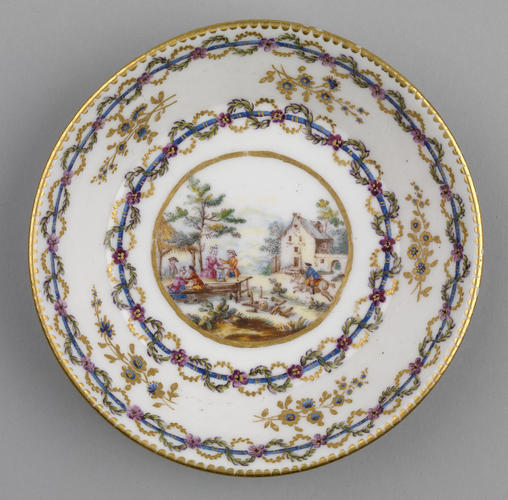
Sèvres porcelain factory
Master: Gobelet litron 1780
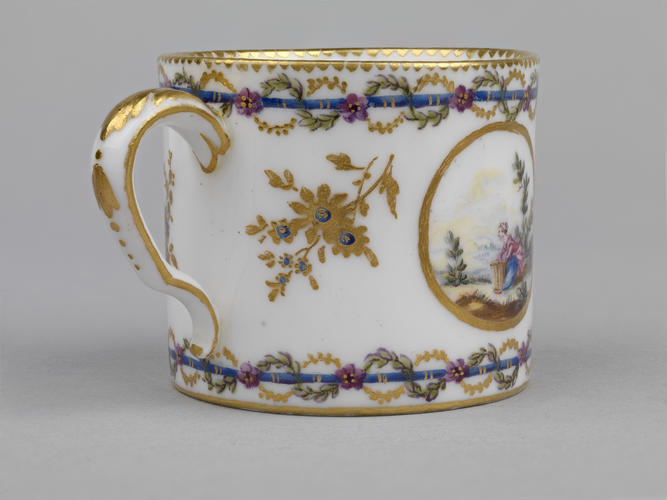
Sèvres porcelain factory
Master: Gobelet litron 1780
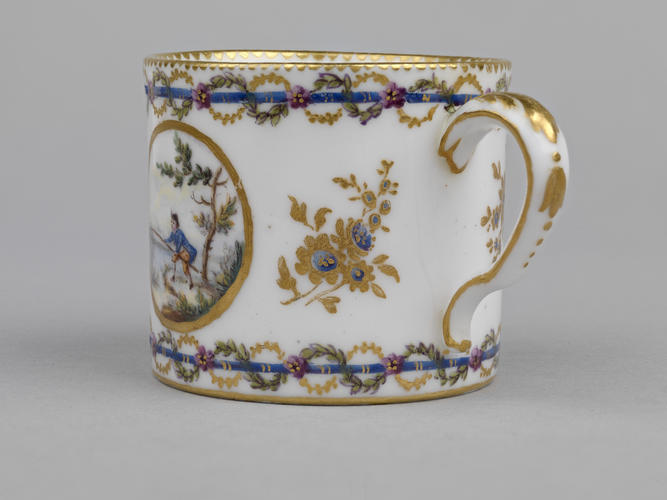
Sèvres porcelain factory
Master: Gobelet litron 1780

Sèvres porcelain factory
Master: Gobelet litron 1780

Sèvres porcelain factory
Master: Gobelet litron 1780

Sèvres porcelain factory
Master: Gobelet litron 1780
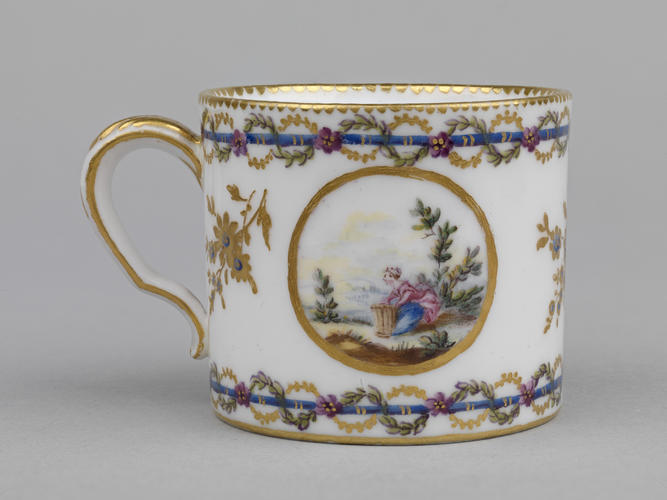
Sèvres porcelain factory
Master: Gobelet litron 1780

Sèvres porcelain factory
Gobelet litron 1780
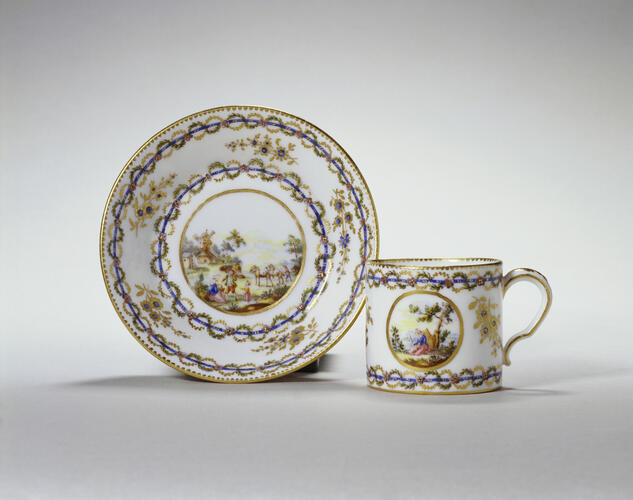
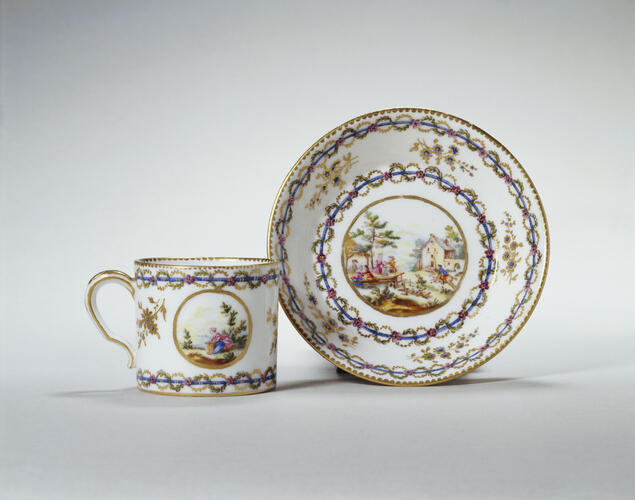








-
First produced in 1752, the gobelet litron was a popular model at Vincennes and Sèvres throughout the eighteenth century. The cylindrical cup received its name because of its resemblance to the litron, an old wooden cubic measure of slightly larger dimensions, used to quantify salt, grain, flour and peas.
The gobelet litron was among the earliest ‘useful wares’ produced at the manufactory. Although the vast majority of gobelets litrons were made to be used, some were intended to serve as eye-catching knick-knacks for display on chimneypieces and occasional tables. They were perfect gifts and towards the end of each year the production of expensive gobelets litrons sharply increased in order to provide sufficient stock for the Kings’ end-of- year sales staged in Versailles. While matching sets of gobelets litrons were produced to be incorporated into déjeuners and cabarets, others were sold singly, and yet others were grouped together to form sets of contrasting decoration.
This pair of gobelets litrons is fitted with arched handles edged with a gold line on each side and decorated on its outer, upper surface with a gilded acanthus leaf, below which is seemingly suspended a gilded husk and a line of four dots. Each saucer has sharply angled sides. They are painted in polychrome with flowers, garlands and landscape scenes, the scenes set in circular reserves (two on each cup and one on each saucer). Gold bands, which run round the rims of the cups and saucers, are notched on the inside and outside. A border, composed of a blue rod entwined with two laurel trails (one green and the other gilded) which are overlaid where they cross with a red flower-head, encircles the top and bottom of the cups, the inner rim of the saucers and the perimeter of their wells. The ground is decorated with scattered sprays of flowers in gold and blue. Matt gold bands frame the reserves.
In the scenes on the cups single figures are painted in a landscape setting: a kneeling woman in a red dress and blue apron with a basket, and a fisherman carrying a net, who is dressed in a blue coat and golden-coloured breeches and a seated peasant woman with a basket on her back and carrying a stick, who is wearing a red dress with a blue bodice, and a man dressed in a red jacket and blue breeches, who is brandishing a stick. On one saucer five figures are seated round a table al fresco drinking, while in the middle distance a horseman gallops past a house on the other three figures converse in the foreground (man, woman and child), while in the middle distance a peasant drives three packhorses towards a windmill and a small house.
The rather naïve, diminutive landscape scenes and the entwined garlands on the border are typical of the style of André-Vincent Vielliard père (active 1752-90) in the 1780s. He was a prolific artist and admired for his industry and appreciated for his skill as a painter of landscape scenes. Entries in the painters’ ledger dated 17 May, 31 May and 21 July 1780 record payments made to Vielliard of 3 livres and 4 livres per cup and saucer for painting borders and landscapes on a total of eighteen gobelets litrons. This pair of gobelets litrons may well have been two of these eighteen cups and saucers.
Text adapted from French Porcelain: In the Collection of Her Majesty The Queen, London, 2009Provenance
In the Royal Collection by 1907
-
Creator(s)
(porcelain manufacturer)(porcelain painter)(nationality) -
Medium and techniques
Soft paste porcelain, white ground and gilded decoration
Measurements
.1 Cup 4.7 x 7.0 x 5.3, saucer 2.4 x 10.6 cm, .2 Cup 4.6 x 6.8 x 5.0, saucer 2.2 x 10.8 cm (whole object)
Other number(s)
Place of Production
Sèvres [France]







